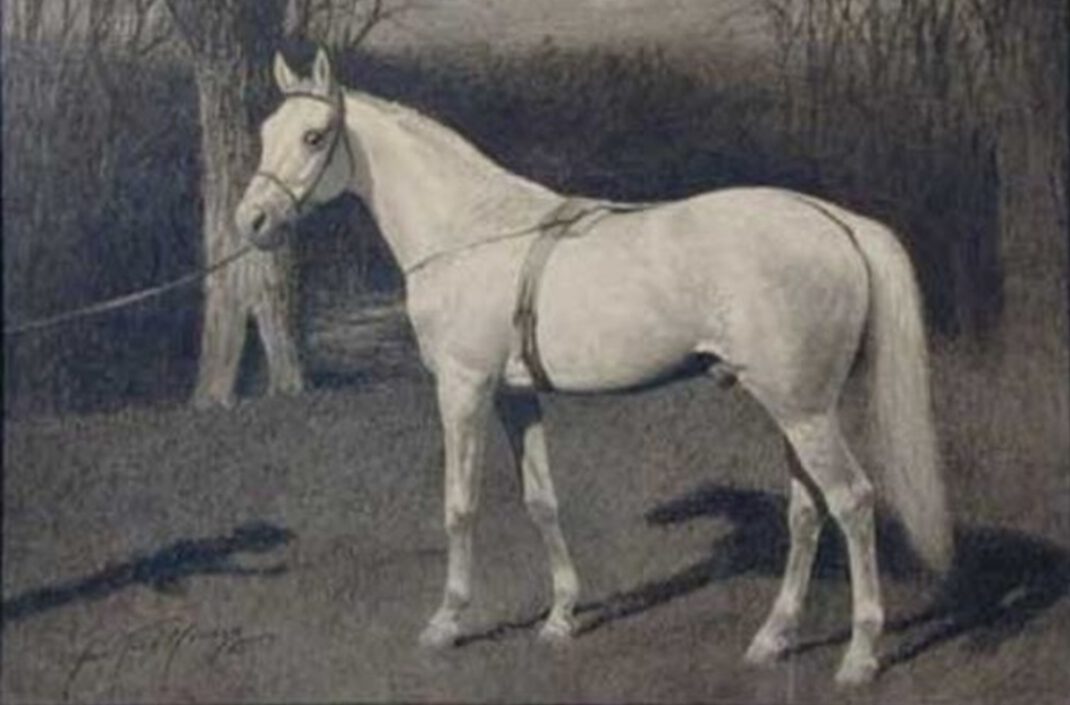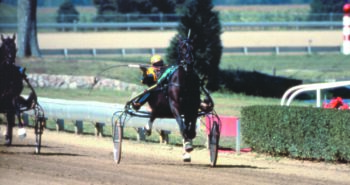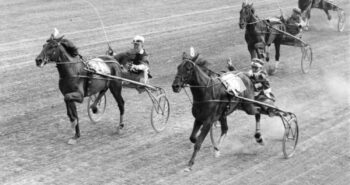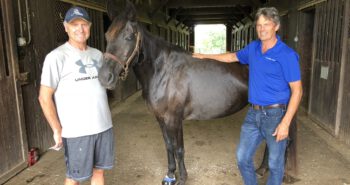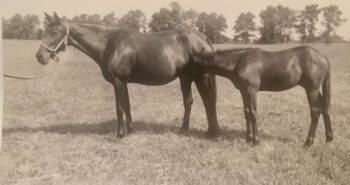He is often thought of as a backwater stallion who fluked one great son despite being a lame horse not good enough to race. However, nothing could be further from the truth when it comes to Pilot Medium, who was one of the best American sires toward the end of the 19th century.
While many good stallions have a distinguished racing career, Pilot Medium never even started a single race. Though he is now often referred to as a lame and crippled horse, the horse was initially sound but damaged his hip badly as a youngster. From The Saint Paul Globe on Oct 1, 1888, “The undeveloped grey stallion, Pilot Medium, owned by Walter Clark, of Battle Creek, Mich., is coming into prominence as a sire through the creditable performances and records of his get (…) He was bred and raised by Alex Davidson, of Williamsport, Pa., and, after he had injured himself by jumping over a fence as a youngster, he was sold to Mr. Clark for $175. He was sired by by Happy Medium, and his dam was the famous of trotting mare Tackey, by Pilot Jr, the dam of Naiad Queen 2:20 1/4 (1.27,2), Pilot Boy 2:20 (1.27) and Class Leader 2:22 1/2 (1.28,6). Mr. Clark has got a bonanza, at a small price, in Pilot Medium.” While the stallion could be characterized as cheap by virtue of his purchase price, but at 10 the stallion was “earning about $5,000 a year for his owner”, and in 1889 the stud fee was set at $200.
In fact, Clark later revealed the horse earned him $10-12,000 per year, thus indicating Pilot Medium had 50-60 foals yearly at that point. It indicated a quick rise to prominence for the stallion who started from scratch, only getting the chance with Clark’s own mares plus a few others. Pilot Medium, however, won over breeders by producing very well from the beginning. In an article in The Saint Paul Globe on Apr 2, 1888, it said that “Pilot Medium is but eight years old, and has to his credit more than nine winners, among them two four-year-olds, with records better than 2:30 (1.33,2); another four-year-old has a record of 2:34 1/2 (1.36), but has shown in races his ability to trot in 2:25 (1.30,1).
The first star
The best of his early foals was the gelding Jack, bred by the stallion’s owner Walter Clark and born when Pilot Medium was only 4. Jack was significantly smaller than his sire, though this was attributed to his dam being pony-sized at 13.2 hands (137 cms), but he had inherited his sire’s grey coat and appearance. The gelding was a natural trotter who raced with minimal equipment. After a win in Rochester, on Aug 15, 1888, the Boston Globe wrote “Jack was bred by Walter Clark. He is by Pilot Medium, dam by Magna Charta, second dam by son of Hill’s Black Hawk. When 4 years old he made a record of 2:29 1/4 (1.32,8) and last year he won 17 of the 19 races in which he started. He is a handsome long-gaited gray gelding, and was driven by Budd Doble.”
Jack kept up his winning ways and was the winningest trotter on the Grand Circuit in 1888 with $12,403 in earnings. His crowning achievement came on Aug 2, 1890, in Detroit when the grey star defeated Leland Stanford’s world champion Palo Alto in a match race in Detroit. From The Sun, “The great match trot between Senator Stanford’s California stallion Palo Alto and George H. Middleton’s gray gelding Jack for $5,000 a side and to settle the question of breeding was trotted on the Detroit track this afternoon in the presence of 5,000 persons, Jack winning after a desperately contested race.
The track was very fast and the weather hot. (…) In the pools Palo Alto was the favorite at $100 to $60 for the race, and $100 to $75 for the heat. Marvin was behind Pao Alto and Doble drove Jack. In the first heat, Palo Alto drew the pole, and on the third trial they were sent off with Jack at Palo Alto’s wheel. At the beginning of the lower turn Palo Alto broke badly and Jack opened a gap of a length. All the way around Marvin had trouble with the Californian, and Jack was a winner by four lengths in 2:15 1/2 (1.24,2) . The second heat was a remarkable race to the quarter where the pair were head and head. Dole in his anxiety drove Jack off his feet, and could not catch the stallion, although he kept the gelding’s nose to Marvin’s wheel. In the stretch both horses were under the whip, Palo Alto winning the heat by a neck. Time 2:13 1/2 (1.23), Jack’s time was 2:14 (1.23,3), a second better than his record. The talent and pool sellers, who insisted on playing the long end of the combination, gathered courage and offered $25 to $19 against Jack. They were even at the start, but on the lower turn Palo Alto went into the air and Jack had three lengths the best of it when the Californian settled down. Palo Alto outfooted Jack up the backstretch, and was right at his wheel when he broke again, losing three lengths. At the three-quarters he had cut it down to a length, and, coming into the stretch, he was going very fast. He had not time to make up the distance, however, and Jack won by a nose in 2:15 (1.23,9). Palo Alto was still favorite at $25 to $16. Again, they got a splendid start, but the stallion was ugly and broke at the quarter, losing four lengths. He broke again at the half, losing still more. Coming into the homestretch, Jack made a skip that lost him two lengths, and the two came down the stretch with Palo Alto at Jack’s wheel. Both Doble and Marvin were driving like madmen, but the gray had the most speed, and won by a neck in 2:16 (1.24,5).
The great race was over, but the crowd was satisfied, as they had seen the fastest heat ever trotted in a race, and the four fastest miles ever trotted in one race. George Middleton of Chicago, owner of Jack, said after the race that he would match him against any horse in the world for any amount of money.” The four miles were the fastest ever trotted in a race. A few days later numerous newspaper printed a poem which made it all very clear:
Palo Alto and Jack
No longer we’ll hear the Pacific Coast hummers sing
What, Palo Alto
Beaten by Jack?
By Jim crack!
’tis a fact.
No longer we’ll hear the Californians sing
Stanford and Marvin
The great and noble
Beaten by Doble
’tis really woeful
The Electioneer boom is busted – Pilot Medium is king.
This loss was tough for Palo Alto’s supporters and Leland Stanford immediately challenged George Middleton to a rematch. In Chicago three weeks later Palo Alto got his revenge, winning in three straight heats, the Californian stallion benefitting from Jack going off-stride while appearing to be on his way to a win in the second heat. After the race, several commentators pointed out that Jack was at a disadvantage on the track because of his “notoriously troublesome” feet. Regardless, the grey gelding had shown what he – and his sire – was capable of. A few weeks later Jack trotted a time trial in 2:12 (1.22), a time he bettered to 2:11 1/2 (1.21,7) in 1892.
“A feat never accomplished“
Pilot Medium was not a one-trick-pony, though, and sired numerous fast trotters. What is particularly interesting is that the colt had absolutely no support from any of the big stud farms or breeders. Pilot Medium’s rise to become a top stallion was thus accomplished by the grey horse himself, as few of the broodmares he was bred to even had a record. In The Gazette, on Nov 15, 1889, it said, “of all the young horses that have come prominently before the public during the past two years, none have exhibited so many proofs of being a wonderful sire as Pilot Medium. His inheritance made him truly great, for from Happy Medium and Tackey 2:26, he inherited the qualities that got Jack, Lady Bullion, and a host of other fast young horses that have been making records.”
By 9, Pilot Medium had four get in the 2:30 list and he was one of only four stallions to accomplish that by that age. However, the grey stallion was just getting started, “In Alcantara, the sensational trotting sire of the year, the Wilkes family receives another boom. Nutwood and Electioneer forge to the front also, but less prominently. So do Pilot Medium, Happy Medium and Mambrino King in a still lessened degree. The greatest sires of 2:30 performers in the world today are George Wilkes, Blue Bull, Happy Medium, Electioneer, Hambletonian 10, Nutwood and Alcantara, but age and opportunities considered, Pilot Medium, a son of the mighty Happy Medium, surpasses all others, having placed twelve in the list this year at the age of eleven, a feat never accomplished by any other stallion living or dead.”
In the Detroit Free Press on Dec 5 1889, “Battle Creek is getting quite a reputation abroad as the home of Pilot Medium, and nearly every day there are strange horsemen in the city looking for stock bred from him. Yesterday Col. Carl Hodges, a resident and well known horse fancier, sold a colt to A.H. Orth, of Minneapolis, for which he received the sum of $5,000. This colt was a 2-year-old stallion by Pilot Medium, dam Belle of Jefferson, by Belmont, second dam Fly, by Woodpecker, a thoroughbred. The colt is known as Thornton, and the sale was a cash one. The colt was shipped to Minneapolis yesterday. Everything in the way of horseflesh that can show a relationship to the Pilot stock is eagerly sought and commands marvelous prices.”
One trainer who absolutely loved Pilot Medium get was Budd Doble. The legendary horseman, who steered Dexter, Goldsmith Maid and Nancy Hanks to numerous world records, was extremely high on the grey stallion. Doble trained Jack, Lady Bullion and others. The mare Lady Bullion 2:16 3/4 (1.25,0), purchased in 1890 for $15,000, was one of the better racing mares of her time. Her purchase price was also the highest ever for a Michigan-bred at the time until Pilot Medium’s best-known son was sold almost a decade later. In March 1890, Doble purchased the gray gelding Girflue. The previous year the then-3-year-old had trotted to a 2:28 3/4 (1.32,4) record for Chicago-based trainer Peter Johnston. The latter didn’t mind that much as he was about ready to retire, anyway. He wasn’t done with Pilot Medium get, though. The Chicago-based Johnston sold his horses and equipment, and retired to Kalamazoo. There he was lured out of retirement to break a Pilot Medium colt.
In 1893 Walter Clark received an offer of $90,000 for Pilot Medium, which he turned down. The same year one of his sons almost won the very first Kentucky Futurity. That was the colt Medio – not to be confused with the legendary broodmare by the same name – who won the first two heats, but lost the next three, and the race overall, to Oro Wilkes. None of Pilot’s get were nominated the following year, but his son B.B.P. was still one of the best three-year-olds of 1894 and won the inaugural Review Stake in impressive fashion.
In The Journal and Tribune on Jan 10, 1896, it said “Pilot Medium, the celebrated stallion owned by Walter Clark of this city, and valued at $100,000 died suddenly today of inflammation of the bowels.” At the time of his death, Pilot Medium was he sire of 47 trotters and 4 pacers with a standard record, i.e. 2:30 or better, including B.B.P. 2:09 3/4 (1.20,6), Piletta 2:11 1/2 (1.21,7), Jack 2:11 1/2 (1.21,7), Pilot (Lee’s) 2:12 1/2 (1.22,3), Pilot Boy 2:13 1/4 (1.22,8) and Racine 2:14 1/4 (1.23,4).” The Breeder and Sportsman wrote that “He founded a family peculiarly his own in conformation, gait and color, and all of his progeny were noted for their gameness, splendid limbs and speed.”
However, the best was yet to come. In 1890, the Sun-Journal had written that “it is doubtful if Pilot Medium ever gets a faster trotter or greater campaigner than Jack.” As it turned out, they were dead wrong. The excellent Pilot Boy lowered his time to 2:09 1/4 (1.20,3) in 1897, a time equaled by the then-11-year-old Waubun in 1902. Still, it was the Pilot Medium colt assigned to Peter Johnston who would guarantee his sire immortality. Eventually named Peter the Great in honor of his trainer, the colt grew up to legendary. On the track he won the 1898 Kentucky Futurity, and the following year he took a record of 2:07 1/4 (1.19,1), but as a stallion he was truly extraordinary, siring numerous star trotters. However, Pilot Medium was a legend in his own right, too, overcoming enormous obstacles to become one of the best – if not the best – sire of his day all by himself.
pilot medium
Grey colt born in Williamsport, PA in 1879. Died in Battle Creek, MI on Jan 10, 1896.
Happy Medium – Tackey (Pilot Jr)
unstarted
Breeder: Alex Davidson
Owners: Alex Davidson – Walter Clark
Trainer: –
Driver: –
Groom: –

